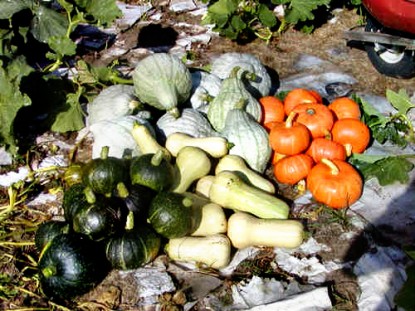
Its that time again. The squash plants are blooming! Time to get out the tape and bright ribbon and start pollinating by hand! I love growing squash! I am obsessed with squash like other gardeners are obsessed with tomatoes!
Since bees are the only insect that pollinate squash, I started doing the job myself in recent years. It has made a big difference in the number of squash produced. If you usually get a lot of flowers and very few fruits, you may have a pollination problem.
Hand pollinating is so easy and its fun! I think its fun, anyway. You may think of it as work.
Squash/pumpkin plants, unlike a lot of other vegetables and ornamentals, have both male and female blossoms. The male and female blossoms are very easy to tell apart.
The female blossoms have a receptacle to receive the pollen. This is a female squash/pumpkin blossom:
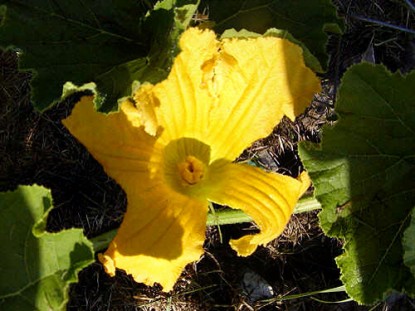
The female blossoms grow attached to the stem by a tiny, undeveloped fruit and usually grow on the side runners.
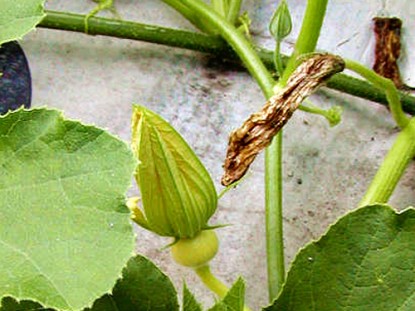
The male blossom has a small stick covered with pollen. This is a male squash/pumpkin blossom:
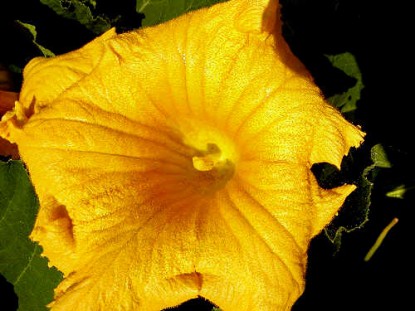
The male blossoms grow on a tall stalk, usually towards the center of the plant.
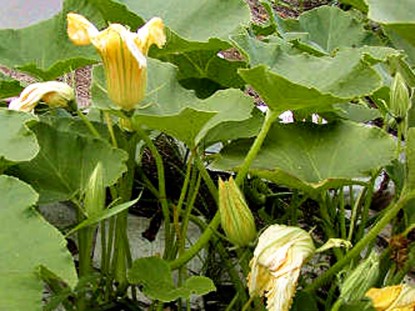
As you can probably guess, the object here is to get the pollen from the male blossom into the receptacle of the female blossom. Easy!
At first I used a paintbrush or a finger to capture the pollen and transport it, but shortly discarded that method. Its not necessary. There are usually several male flowers open for every female, so I just pick a male flower, remove the petals and rub the pollen against the female receptacle. You can use one male flower to pollinate 2-3 female flowers, if necessary.
Occasionally there will be a few female flowers open early without any male open to pollinate them. This can be frustrating! That happened to me this year. There were two female ambercup squash flowers open early and no males yet. I pollinated these with male blossoms from a buttercup squash plant nearby. They are both maxima so I know they will cross pollinate. Most of the squash I grow are maxima.
I do want pure seed to save for next year but I knew there would be a lot more squash blossoms coming later. More than enough to ensure pure seed for next year.
It is important, when pollinating to ensure pure seed for the following year, to pollinate the blossoms as soon as they open, very early in the morning of their first day before they are likely to be pollinated by a bee. I went out at dawn a few days later, my usual time, and found several female flowers just opening. Perfect!
I pollinated these with pollen from a just opening male flower of the same type and taped the blossom shut with masking tape. You can see the little bulb at the base of the female blossom.
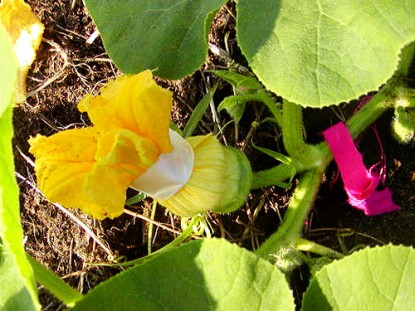
This is a buttercup female blossom just opened this morning, pollinated and taped shut to prevent further contamination from bees with pollen from other maxima squash growing nearby. Cross pollinating squash plants won’t affect this year’s produce at all, but it will mix up what you get from the seeds the following year.
Some people advocate going out in the early evening and taping shut any female and male blossoms that you think will open for the first time the following morning. This will prevent any pollination before you get to them. I have not found this to be necessary as I am usually out in the garden at dawn, anyway.
I marked the hand pollinated ones with a bright pink ribbon so that I will know it is a “seed” squash when it is harvested. Anything that will last through the summer and into the fall and still be recognizable will do. It doesn’t have to be pink!
When fall comes I will leave these ones on the vine as long as possible to ensure ripeness. The squash grown for seed will need to be very ripe to get the best developed and driest seed. These will sit in the field in the sun long after the vines have died from frost. Then they will be brought inside and put in the basement to age at least another month before being cut open and used.
This year I have growing: 12 hills of ambercup and 10 hills of turban buttercup with 3-4 plants per hill of each, 3 pink banana squash plants, 1 spaghetti squash plant, 1 “upper ground sweet potato” squash plant, 2 “sweet mama” squash plants, 3 Hopi black squash plants, approx 4 Hopi gray squash plants and 2 acorn squash plants. Most of the ones I grew this year, except the acorn, are maxima, so cross pollinating would be a problem if done naturally.
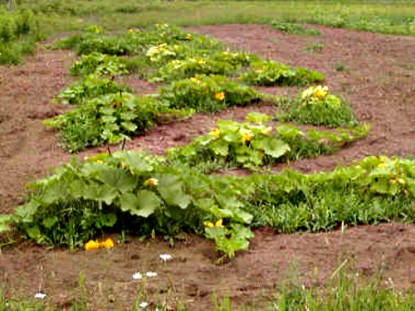
I saved a bag full of good dry seed from the giant blue hubbard I grew last year but decided not to grow it again. Its not as sweet as the ambercup, which is delicious, but it is, nevertheless, a tasty dry squash. The hubbards are also more work to process and have to be cut with the axe, or a very sturdy knife and a hammer. I didn’t need another variety this year, so I left it out.
I planted the Hopi squash mainly for seed, although I have read that the gray is one of the best keepers out there. These Hopi squash were the original ones used for the “three sisters” system originating with the Hopi Indians. When I looked into growing them a few years ago the seed was almost impossible to find. I did manage to find one lady who sent me some in a trade and I have kept them until this year. I had my doubts that they would germinate after three years, but they did! They were slow to germinate and I am not sure they will have time to produce mature fruit this year, but I have high hopes! I do so want those seed to preserve and sell next year! We are losing so many good heritage varieties of all our vegetables!
I like to putter in the garden. I often just walk around and look and putter when I am relaxing. This is when I do the pollinating of squash blossoms, tying up and de-suckering the tomatoes, lifting up the stray cucumber vines and so forth – the little things. I keep everything I need in a little basket with a handle and take it out with me on all of my walks. I don’t take the hoe!
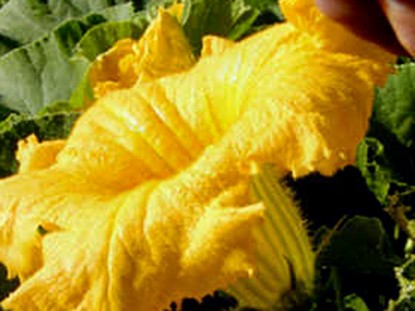
Every part of the squash plant can be eaten, including the leaves and tender shoots.
I plan to cut off the side shoots when it gets too late for the plant to grow squash that will ripen in time. These tender shoots are going into soups and stews. I want to try them chopped in omelets this year. The young leaves can be picked now and used as wraps around some meaty concoction, much like a grape leaf can. We have lots of wild grapes too. I think I’ll experiment this summer with leaf wraps!
I have collected a selection of squash recipes that we have found to be delicious and have made many times. Winter squash and sweet pumpkin are interchangeable in any recipe, since they are the same thing. No canned pumpkin will ever taste as good as the home grown vegetable.
*Note: All spices are dried and ground. If you wish to use fresh, you will need to research the amount.
Squash Pie
1 1/2 cup squash, cooked, mashed and unseasoned
1 teaspoon ginger
1 teaspoon cinnamon
3 eggs
2 teaspoon all purpose flour
1/8 teaspoon nutmeg
1/2 teaspoon mace
1/4 teaspoon salt
1/2 cup milk
>Mix all dry ingredients together. Add squash. Beat eggs in another bowl and add milk to eggs, then add to squash mixture. Pour into an unbaked pastry lined pan. Bake at 350F until firm in center, about 1 hour.
Save Squash Pie to your Recipe Box or print out.
Squash Loaf
3 cups sugar
4 eggs, beaten
1/2 teaspoon cloves
2/3 cup water
3 1/2 cup all purpose flour
2 teaspoon salt
1 teaspoon allspice or 1/2 tsp mace
1 cup oil
1 teaspoon baking powder
1 teaspoon nutmeg
2 1/2 cup squash, cooked, mashed and unseasoned
2 teaspoon baking soda
1 teaspoon cinnamon
Heat oven to 350F, grease 3 loaf pans. Mix sugar, oil and eggs. Add squash. Sift together all dry ingredients and add to squash mixture. Add water and pour into pans. Bake 1 hour.
Save Squash Loaf to your Recipe Box or print out.
Squash Soup
2 pounds uncooked squash
1.5 pints of stock, chicken or vegetable (can be made with bouillon)
1 medium onion, diced
1 garlic clove, crushed
Cream to add before serving, amount is optional
Salt and pepper to taste.
Sprinkle of nutmeg or cinnamon, optional
In a large saucepan, slice and saute the garlic and onion in oil or butter until tender. Add squash, stock, nutmeg or cinnamon, salt and pepper. Boil and cook for 25 minutes until squash is tender. Puree mixture with a blender until smooth and return to saucepan. Before serving, add cream and gently heat. Do not boil.
*Stock amount can be changed, depending on how thick or thin you want your soup.
**Add thick applesauce for a special taste treat.
Save Squash Soup to your Recipe Box or print out.
Squash Muffins
1 cup squash, cooked and mashed
1/3 cup oil
1/4 cup light corn syrup
3 teaspoons baking powder
1/2 teaspoon cinnamon
1/4 teaspoon nutmeg
1 cup sugar
2 eggs
2 cups all purpose flour
1/2 teaspoon salt
1/2 teaspoon ginger
1/4 teaspoon mace
Preheat oven to 350F. Grease muffin tin or use papers. Mix together squash, eggs, oil and corn syrup in large bowl. Stir until well mixed. Stir all other dry ingredients together in smaller bowl. Add dry ingredients to squash mixture. Fill greased tins to the top. Bake in preheated oven for 20-25 minutes until lightly brown on top.
* Very good with raisins added, add raisins to batter if desired.
Save Squash Muffins to your Recipe Box or print out.
Squash Dessert Squares
1/2 cup shortening
1/4 cup sugar
2 cups squash, cooked, mashed and unseasoned
4 teaspoons baking powder
1 teaspoon cinnamon
1/2 teaspoon nutmeg
1/2 teaspoon ginger
1/2 teaspoon salt
1 cup brown sugar
3 eggs
2 cups all-purpose flour
Preheat oven to 350F. Grease square pan. Beat together shortening, brown sugar and white sugar until light. Add eggs, one at a time, beating after each addition. Beat in squash. Combine dry ingredients and gradually stir into beaten mixture. Spread in greased pan. Bake for 30 minutes. Cool in pan. Spread with orange icing (optional). Cut into bars.
Save Squash Dessert Squares to your Recipe Box or print out.
You can also find Sheryl at Providence Acres.Interested in contributing a guest post to the Farm Bell blog? Read information here for Farm Bell blog submissions.
Want to subscribe to the Farm Bell blog? Go here.



Laura says:
Sheryl—-what a delightful blog!!! I loved it. I love to learn, so your tutorial on pollinating the squash as great and had such nice pictures. I also appreciate all the yummy recipes you posted. This was a gem to read this morning.
On July 17, 2010 at 10:32 am
Moopsee says:
I must say that this was an absolutely excellent blog! You did a terrific job at explaining pollination of squash. And…to find yet another seed saver in the world — just awesome. It is one of the best feelings ever to save seeds.
I will have to do some research on the ambercup. That variety is new to me.
Great recipe posting as well!!
On July 17, 2010 at 12:57 pm
Darlene says:
Thank you for such a wonderful post. There are so many vegs that I would like to grow but have zero knowledge about them. I’ve saved this post so next year I can add squash to my little garden. I’ll be saving some seed…..thank you very much!
On July 17, 2010 at 1:11 pm
LisaAJB says:
Wow, really good information. I’m growing 2 squash plants this year. 1 winter and 1 French variety. Name starts with a G, sorry that’s all I remember. I’ve never grown squash before, but thought it would be fun. I did not realize how BIG the plants would get. I probably wont save the seeds this year since it is my first year growing squash, but I do save the seeds of many of my garden vegetables, and I love to read about others doing the same. We have a wasps nest near our garden (that I HATE) which does a pretty good job of pollinating my veggies. Thanks for the recipies! I’m excited to try them this fall.
On July 17, 2010 at 1:30 pm
Kat says:
You need to get some bees!
On July 17, 2010 at 1:54 pm
Pete says:
Yummy! Love all the squash recipes!! Each one sounds delicious.
A question about growing squash: Is using cages for growing them in small spaces OK? Might it depend on the type of squash, how heavy, etc? (I’m trying it, but may or may not be having success with this method!)
On July 17, 2010 at 2:03 pm
Sheryl - Runningtrails says:
Thanks so much, everyone! I’m glad its helpful!
Small squash will grow successfully on fencing. I have trellised acorn squash before successfully. I am growing more acorn squash and also ‘sweet mama’ squash on fencing this year.
You can grow large ones on fencing too, if you support them with a sling when they begin to get heavy. Needs to be a strong fence/trellis. Panythose make good slings under the individual squashes, tied to the trellis.
Squash plants do get huge!
On July 17, 2010 at 9:08 pm
Cathy Jones (catray44) says:
Thank you for writing this. The recipes look wonderful. I was frustrated as my zucchini blossoms(Of all things!) were falling to the ground, unpollinated. I mean, who can’t grow zucchini? lol. I am heading out right now to see if I can fine some male and female blossoms!
On July 18, 2010 at 7:50 am
Pete says:
Thanks, Sheryl, for the feedback. So far it seems to be working – in the “four cousins” garden. Four tomato cages with four different vines growing on them.
Have never grown zucchini before and have been watching them soooo closely, and was disappointed that there was no fruit on them. Just looked this morning and found three of the biggest zukes I’ve ever seen! They have been hiding all this time. Not for long now!!
On July 18, 2010 at 8:09 am
Sheryl - Runningtrails says:
That happnes to me too. There are always a few that hide until they are massive.
On July 18, 2010 at 5:17 pm
Jill says:
Thanks for the recipes! My stepmother makes squash pie and I always ask for it for my birthday!! But the other two I will definitely try. I have yellow squash all over the place this year and it’s my favorite. I don’t have to hand pollinate – every time I go to pick a sqash and bee comes out of another bloom!
On July 19, 2010 at 7:53 am
Sheryl - Runningtrails says:
You’re very welcome, Jill!
These recipes are for winter squash. I should have added that to the blog. It just wouldn’t be the same with green or yellow zucchini or crooked neck summer squash.
On July 19, 2010 at 1:09 pm
Jill says:
Actually, my stepmother makes squash pie with yellow crookneck squash and like I said, it’s my favorite. The recipes are very similar.
On July 20, 2010 at 7:42 am
Sheryl - Runningtrails says:
Interesting! That would be so different from regular squash/pumpkin pie. Something unuual to try!
On July 20, 2010 at 11:39 am
Shabbysewer says:
Thank you so much for this wonderful post. It explains in perfect detail how to do this. I love squash also. I did not have a good crop this year, had to buy a bushel. Every day I learn something new.
On December 17, 2010 at 8:08 am
TeaCup says:
Looks wonderful…if I could only get 1 squash I’d be happy! I’ve got some insect that lops all my flowers off at their base right after they open. All the local folk are completely puzzled. Anyone know what might be doing this/what I could do to stop this?
Thanks in advance —
Judi
On June 7, 2011 at 12:01 pm
Sheryl - Runningtrails says:
Are you sure it’s an insect and not a rabbit, ground hog, rat, mouse, etc?
On June 7, 2011 at 12:54 pm
Sheryl - Runningtrails says:
Perhaps you could put a little fence around and over the squash plant?
On June 7, 2011 at 12:55 pm